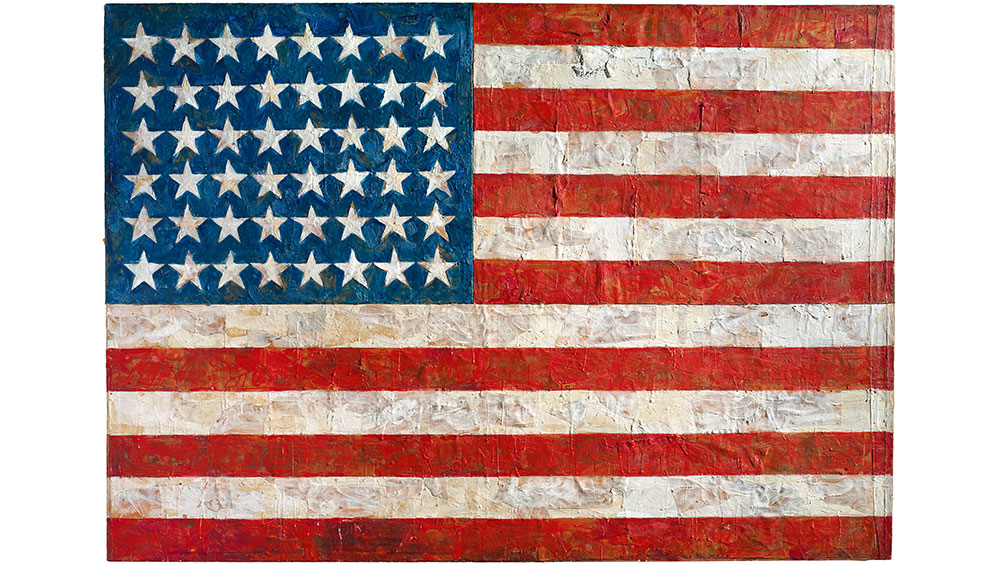
Jasper Johns, Flag, 1954-55. Encaustic, oil, and collage on fabric mounted on wood (3 panels), 41.25 x 60.75 in (104.8 x 154.3 cm). The Museum of Modern Art, New York, NY; Gift of Philip Johnson in honor of Alfred H. Barr, Jr. © 2021 Jasper Johns/VAGA at Artists Rights Society (ARS), New York.
Whitney Museum, New York
and Philadelphia Museum of Art
29 September 2021 – 13 February 2022
by JILL SPALDING
Jasper Johns: Mind/Mirror, the twin peaks exhibitions staged to celebrate Jasper Johns’s 90th birthday but now, due to Covid, feting his 91st (with the happy result that he has produced more art in the interim) have just opened as one at New York’s postmodernist Whitney Museum and Pennsylvania’s traditionalist Philadelphia Museum of Art. A train-ride apart that, albeit a short one, is unlikely to bring the same viewers to both, begs the question: “Why was the Whitney not paired with the Museum of Modern Art – a subway hop north? True, the Whitney’s and Philadelphia’s holdings are equally deep, but MoMA was first, in 1958 (after Johns had destroyed all the previous work he could find), with the acquisition by its director, Alfred Barr, of four out-there but seminal paintings from Leo Castelli that only an agile eye would have purchased for a museum. Indeed, given the quantity of its subsequent holdings, MoMA would seem to be Johns’s alma mater. Thereby, however, hangs too long a tale, ranging from MoMA’s “asleep at the wheel” to Whitney curator Scott Rothkopf’s “on the ball”.
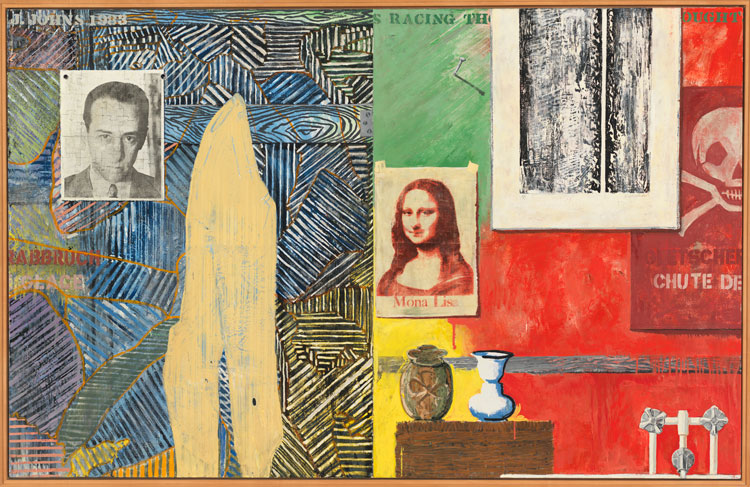
Jasper Johns, Racing Thoughts, 1983. Encaustic and collage on canvas, 48 1/8 x 75 3/8 in (122.2 x 191.5 cm). Whitney Museum of American Art, New York; purchase, with funds from the Burroughs Wellcome Purchase Fund; Leo Castelli; the Wilfred P. and Rose J. Cohen Purchase Fund; the Julia B. Engel Purchase Fund; the Equitable Life Assurance Society of the United States Purchase Fund; The Sondra and Charles Gilman, Jr. Foundation, Inc.; S. Sidney Kahn; The Lauder Foundation, Leonard and Evelyn Lauder Fund; the Sara Roby Foundation; and the Painting and Sculpture Committee 84.6. © 2021 Jasper Johns / Licensed by VAGA at Artists Rights Society (ARS), NY. Photograph by Jamie Stukenberg, Professional Graphics, Rockford, Illinois.
The other “hmmm” is what distinguishes two shows set up to virtually mirror each other. The mission statement weighting the Whitney’s to the flags and the maps and Philadelphia’s to the numbers doesn’t hold up since both have stellar examples of each. More plausibly, apart from sweeping clean an entire museum, a single venue could not have accommodated the more than 500 works here assembled. The very effort of gathering signature work from all over the world calls for deep pockets and broad commitment: (kudos to, among many, such fervent supporters as Leonard Lauder, Ralph Lauren, Agnes Gund, Constance Hess Williams and Larry Gagosian).
My idea of a retrospective would be to hang everything. Everything.
Retrospectives are always tricky. Who is to judge which works sum up a life? How to place works that relate variously by medium, subject and technique? And for the critic, what more to say of work become blue chip that has marked for seven decades? Johns would rather we don’t try. He has lived through musings as far-fetched as comparing his head on a plate to that of St John the Baptist’s on a platter, or tracing his attraction to encaustic (the ancient technique of brushing hot beeswax and pigment on fabric) to his love of cooking and, in particular, to frosting a cake. To forestall such expounding, he told his biographer, Deborah Solomon: “These are not my ideas. This show is not my idea.” He did not, however, block it (he even contributed two works made this year). Rather, he would say, come without baggage, look closely and you will see.
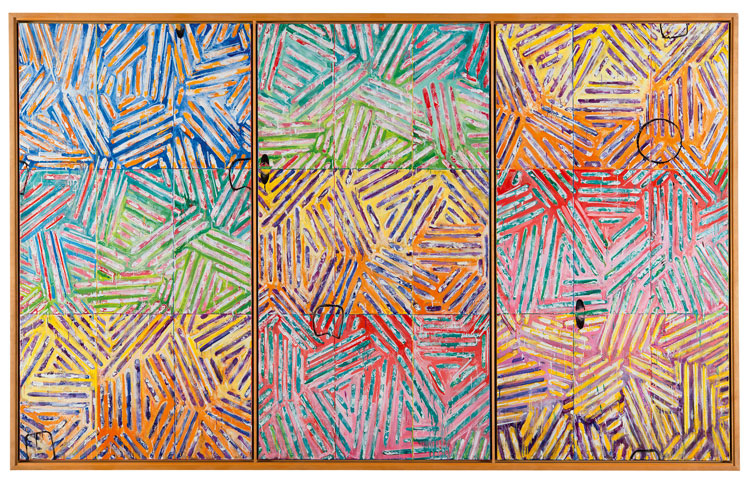
Jasper Johns, Usuyuki, 1982. Encaustic on canvas (three panels), 71 x 113 3/4 in (180.3 × 288.9 cm) overall. Sezon Museum of Modern Art, Nagano, Japan. © 2021 Jasper Johns/VAGA at Artists Rights Society (ARS), New York.
Those mirrored images: what distinguishes the twin flags? (the brushstrokes); the two bronze ale cans? (one is hollow); the crosshatched circles in Usuyuki, 1982 (one is coded as a figure, the other as geometry). The crosshatching itself (adapted after Johns glimpsed it from a passing car: “I only saw it for a second but knew immediately that I was going to use it. It had all the qualities that interest me – literalness, repetitiveness, an obsessive quality, order with dumbness, and the possibility of a complete lack of meaning”) now reads as the precursor of the present zeitgeist move to figurative abstraction. And what of those ashy canvases, once dismissed as dispiriting voids, held together in the 80s by catenaries of string? Be it the Whitney’s superb lighting or our nascent conversance with string theory, they appear here charged with the invisible particles of dark energy, the very universe strung together.
The Whitney has dedicated only one floor to the show, but that one so vast as to seem palatial, its spaces brilliantly rethought to breathe life into the large works and play the smaller ones against each other without dragging them into a lineup.
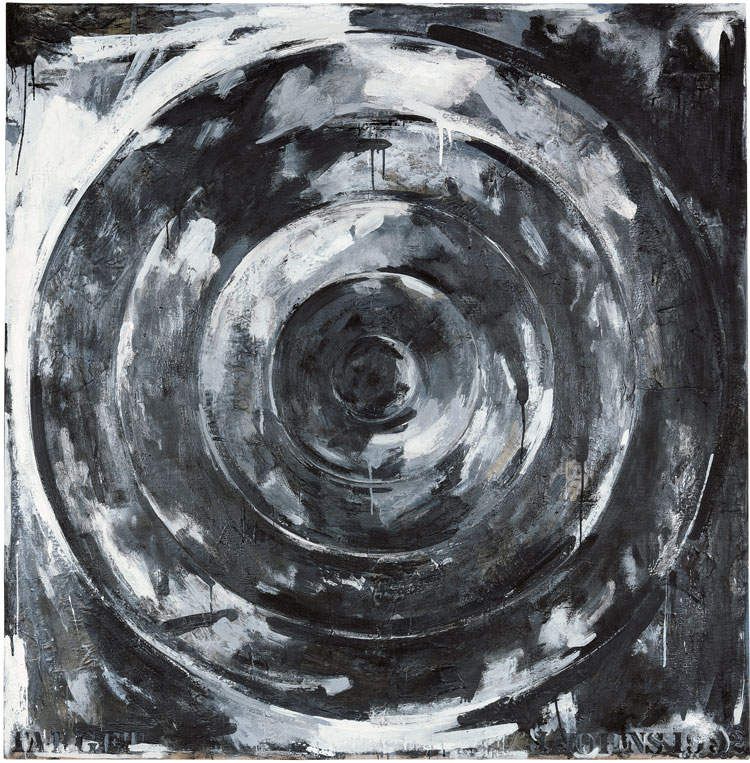
Jasper Johns, Target, 1992. Encaustic and collage on canvas, 55 x 54 1/8 in (139.7 x 137.5 cm). Larry Gagosian. © 2021 Jasper Johns/VAGA at Artists Rights Society (ARS), New York.
Take your time. Reflect anew on the icons – Flag and Target – credited with upending abstract expressionism, ushering in pop art, and crowning Johns king of contemporary art. Revisit the transgressive adventures with stencilled letters, stick figures and flagstones, and marvel at how newly meaningful and major they look now. Above all, surprising. The charcoal and powdered graphite drawings, for example, rescued from a flat monochrome by the lighting, present here as ancient rubbings of an esoteric incunabula.
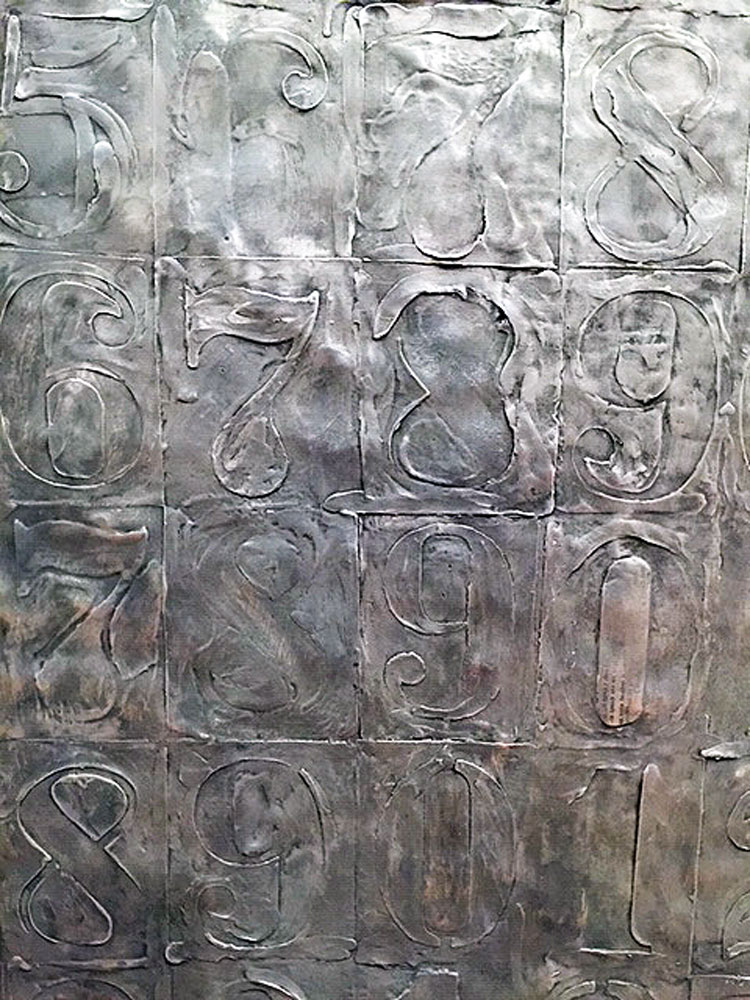
Jasper Johns, Numbers, 1963, cast 1968 (detail). Aluminium. Installation view. Photo: Jill Spalding.
So much has been written – so many reviews, interviews, critical studies (so annoying the artist that he lampooned them in sculpture) – that the critic undertaking possibly the penultimate review of his work might think the lemon squeezed dry. Ha! If anything, there is not enough bandwidth to cover it all. There’s no getting a handle on work that is sui generis, plumbing “things the mind already knows”, whose meaning can mutate like the cells of a body. Dissected over the years for psychological insights, the powerful Target with Four Faces (1968) capped by plaster casts of the half-faces of studio visitors, now reads as a coded pun by a masterful jokester whose aim for the eye is right on the nose. Likewise, Johns’s numbers are numbers, executed in copper, lead, paint and graphite, until they become cosmic shapes, ancient runes – tools of addition and subtraction rethought as the body parts of the cosmos: “Oh, that 7!” exclaimed his long-time collector Gund, newly turned on to them.
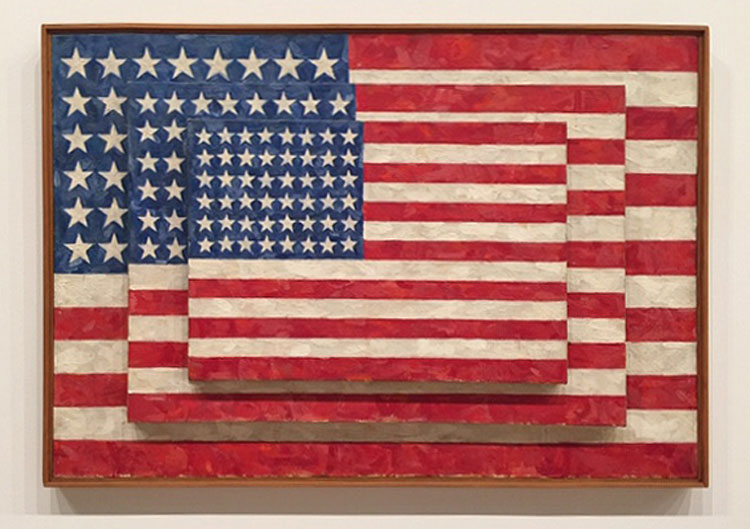
Jasper Johns, Three Flags, 1958. Installation view. Photo: Jill Spalding.
Compare the signature flags punctuating the Whitney show, which entrench his early use of encaustic that first raised his surfaces to textured planes. Long held a critique of co-opted patriotism, the famed, triple-stacked Three Flags (1958), the three-panel Flag composed of unstable materials involving newsprint and auto enamel, and the radiant Flag on Orange Field (1957) that escaped to Cologne, with the passage of time have quietly morphed. Bannered by the thrilling three-panel White Flag (1955), a white-on-white encaustic collage of newsprint on fabric suggesting wheat fields at dusk, they present newly here as seductive native landscapes – those beckoning layered-to-the-horizon western horizontals of pale grain and star-dusted sky that are so very American.
Likewise, all the tropes so long associated with an artist held remote and inscrutable are, like a Zen koan, all up here for re-seeing (“Very good, now go back and look again”), body parts worked into reliquaries; vases into profiles, eyes into breasts. And, to remind of the range, a one-off encaustic-on-wood cartoon commentary, Alley Oop (1958), on pop art.
It’s no wonder that Johns still resists interpretations of a work’s meaning, he is still reinterpreting it. The very day he is working on a Catenary he might revisit a Flag or a flagstone.
Art is either a complaint or an appeasement.
Johns has been pegged and unpegged, buttonholed and set free – hailed as a conceptualist, a minimalist and, most absurdly, an abstract painter, since he was omitted from the Guggenheim’s marking Abstractions show. There is no true assessment because, even for Johns, truth is elusive. Canvas, for example, becomes a material surface that can serve as vessel or script. The plethora of paintings seen here that are affixed with objects flips even his most oft-quoted dictum to: “Take a canvas; do something to it: do something else to it. [Repeat].” Have fun with the visual hints and devices, but stop yourself from reading too much into them.
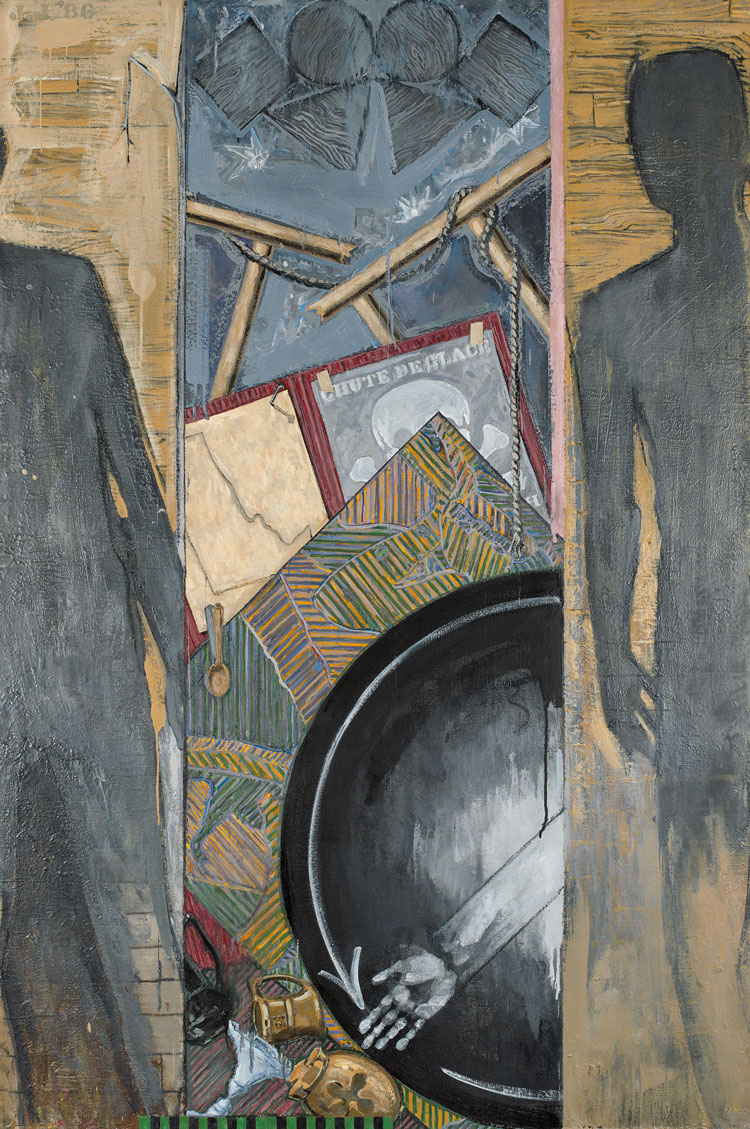
Jasper Johns, Fall, 1986. Encaustic on canvas, 75 x 50 in. (190.5 x 127 cm). Collection of the artist; on long-term loan to Philadelphia Museum of Art. © 2021 Jasper Johns / Licensed by VAGA at Artists Rights Society (ARS), NY.
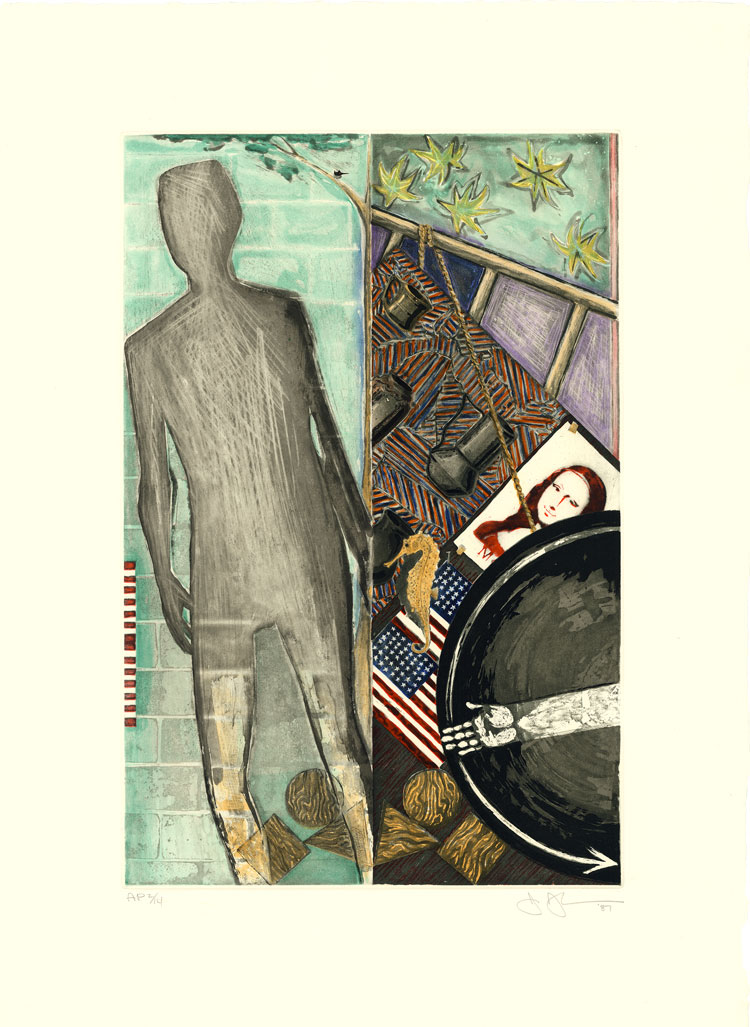
Jasper Johns, Summer, from The Seasons, 1987. Intaglio: five copperplates, 26 x 19 in (66 x 48.3 cm). Printed by John Lund, Hitoshi Kido, Craig Zammiello, Keith Brintzenhofe; published by Universal Limited Art Editions. Edition no. 2/73. Whitney Museum of American Art, New York; purchase with funds from the friends of Victor Ganz in his memory, 88.10.2. © 2021 Jasper Johns and ULAE / VAGA at Artists Rights Society (ARS), New York.
That deceptively autobiographical Untitled (2013-2014) – resist the temptation to read into it the young artist developing his palette as he climbs the ladder to fame. Best to stand back and inhale. I lingered longest in front of Spring and Fall (both 1986) from the prodigious Seasons series, and Untitled (1992-94), the Broad collection’s admittedly autobiographical dreamscape that Johns built from the floor plan drawn from memory of his grandfather’s house, and a coded vernacular involving Picasso, mirrored circles, floated eye, crosshatched geography and a stick figure headed out.
A painting ought to be looked at the same way you look at a radiator.
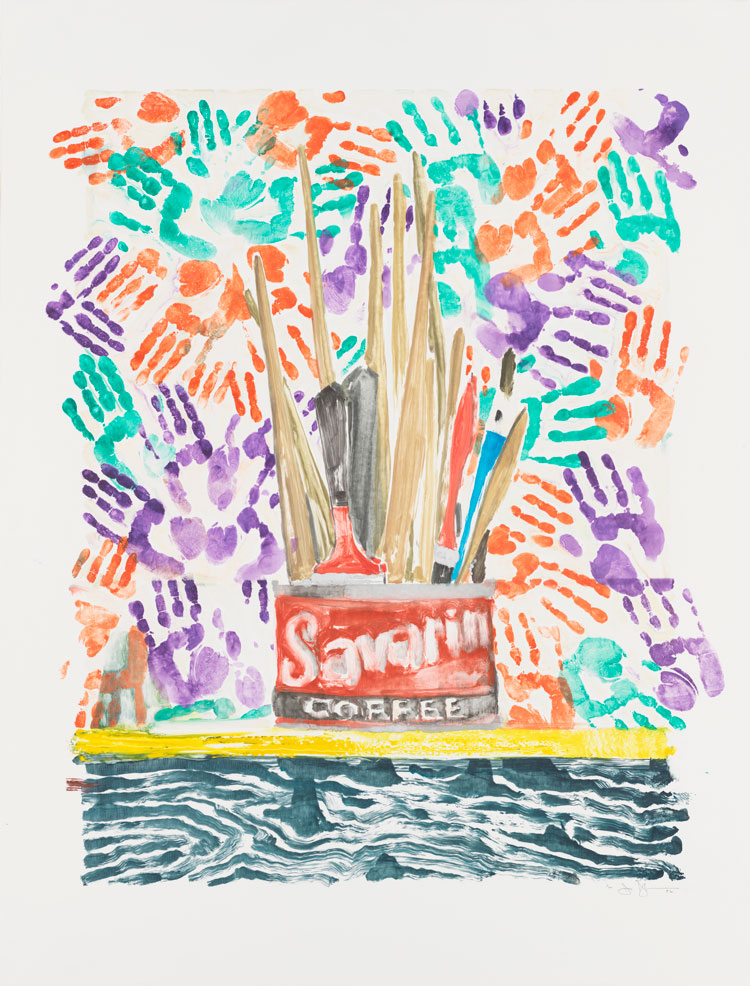
Jasper Johns, Savarin, 1982. Monotype, 50 × 38 in (127 × 96.5 cm). Bill Goldston, James V. Smith, Thomas Cox/ULAE. Whitney Museum of American Art, New York; gift of the American Contemporary Art Foundation, Inc., Leonard A. Lauder, President, 2002.228. Prints published by ULAE © 2021 Jasper Johns and ULAE/VAGA at Artists Rights Society (ARS), New York.
Spend time, too, with the drawings – so many involving paint and collage – but give special attention to the prints, which are so critical to Johns’s development that he lodged his printmaker in his guesthouse. I cannot think of another contemporary artist whose prints and paintings are of an equivalence, drawing on each other to rework and reinterpret – the prints given another dimension with ink, crayon and paint. Likewise, in the superb gallery given over to his 17 Savarin cans holding paintbrushes, see how Johns worked the image up variously from a poster to a bronze sculpture to a monotype. Experienced together, they stir an almost visceral emotion as each becomes its own sequel, like stills of a movie. Gund again: “I’ve changed my mind about the works that I love – I see so much more in the Seasons, for example – but what involves me the most now is the prints.”
Finally, be sure to note the great works in private collections that may not surface again soon. Outstanding among them are the lyrical ink drawing Untitled (2010), a sophisticated riddle challenging the eye to give meaning to negative space, and Mirror’s Edge (1992), a Picasso-style begin-here/end-there board game featuring seven of Johns’s signature motifs.

Jasper Johns, Field Painting, 1963-64. Installation view. Photo: Jill Spalding.
Pressed to find a weak entry I would single out those with the most debt to Johns’s one-time lover, Robert Rauschenberg (I’m thinking in particular of the clutter crowding Field Painting (1963-64) – coincidental that the letter “R” is flashed in neon?), whose facile tropes he soon bypassed but could never quite dismiss. It was not incidental that Castelli, art’s éminence grise, although he discovered Johns later, showed him first. Yes, Rauschenberg opened his lover’s canvas to found objects and appropriated images, but how quickly Johns graduated to a more complex and diverse vernacular.
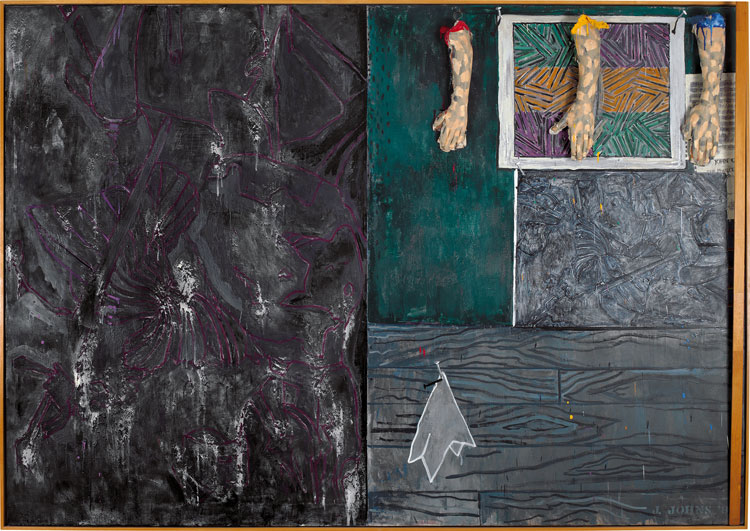
Jasper Johns, Perilous Night, 1982. Encaustic on canvas with objects, 67 1/4 x 96 1/8 in (170.8 x 244.2 cm). National Gallery of Art, Washington, DC; Robert and Jane Meyerhoff Collection, 1995.79.1. © 2021 Jasper Johns/VAGA at Artists Rights Society (ARS), New York.
Speaking to this artist’s hard-won universality, while perhaps it is to be expected that in this racially charged moment much is being made of Johns’s southern prejudice, I find it pandering that the catalogue included comments on his blindness to Black suffering. For the life of me, I can’t trace any prejudice in this artist’s world view. And surely it points to a wider humanity that Johns’s single intervention, we are told, was to mirror the white stick figure on the front cover with one on the back cover that is black.
I use too many things from past paintings. Of course, you have to paint something, but repetition-and-variation as a method seems very limited.
What to say of the mirror exhibition at the Philadelphia Museum of Art? Most refreshingly, although equally scholarly, it is neither themed nor sequential. Whereas, for example, the Whitney shows 36 prints in chronological order, director Carlos Basualdo chose to interplay 34 prints based on a randomised composition by John Cage. I don’t think, however, that it moves the needle to offset the Whitney’s focus on the influence of Johns’s South Carolina upbringing with the Asian-inflected work triggered by his army stint in Japan (and of no significance that Jasper’s nickname is “Jap”).
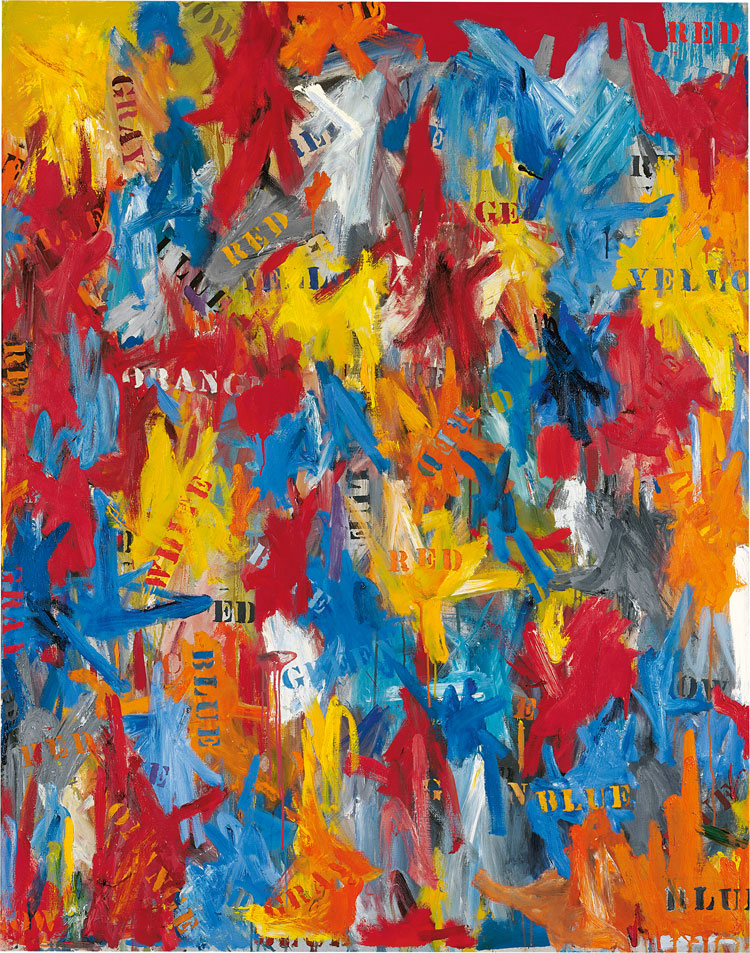
Jasper Johns, False Start, 1959. Oil on canvas, 67 1/2 × 53 1/8 in (171.5 x 134.9 cm). Private collection. © Jasper Johns / Licensed by VAGA at Artists Rights Society (ARS), New York, NY.
Thankfully, although the august institution was built for antiquity, thanks in part to Frank Gehry’s recent intervention, the penumbra opens to some sunlit galleries, and though this is a somewhat smaller exhibit and several walls are too crowded, the museum’s holdings of early work are important and gorgeous. Train it there for the day if only for Winter (1985) and Summer (1986) – to complete the subjective map of the artist’s life journey composed into a primordial soup of body parts, asteroids, appropriated and fantasised images that are both singular and distilled from a lifetime of compilation to form a vernacular as wondrous and nourishing as honey processed from pollen. Shown all together at the memorable 1996 MoMA retrospective (Johns had asked that they be hung on one wall to bring out the cinematic quality of how the shadow figure moves across the canvases), it’s unfortunate that they were divided between the two venues.

Jasper Johns, 5 Postcards, 2011. From left to right: Encaustic on canvas, 36 x 24 in (91.4 x 61 cm); Oil on canvas, 36 x 27 in (91.4 x 68.6 cm); Oil on canvas, 36 x 27 in (91.4 × 68.6 cm); Oil and graphite on canvas, 36 x 27 in (91.4 x 68.6 cm); Encaustic on canvas, 36 x 24 in (91.4 x 61 cm). Philadelphia Museum of Art: promised gift of Keith L. and Katherine Sachs. © 2021 Jasper Johns/VAGA at Artists Rights Society (ARS), New York.
Other marvels abound. Grand to revisit the encaustic 1992 Target spun into a day-for-night nebula; the flamboyant 0 through 9 (and the groundbreaking False Start (1959) placing the colour names on their counterparts, bought in 1988 for $17m by SI Newhouse to jump the artist’s going price by $8m. Reconnect with the double entendres – the Five Postcards (2011) eternalised as paintings, and the famously coded [widely held to be coded male anatomy at a time when homosexuality was frowned on] Painting with Two Balls (1960).
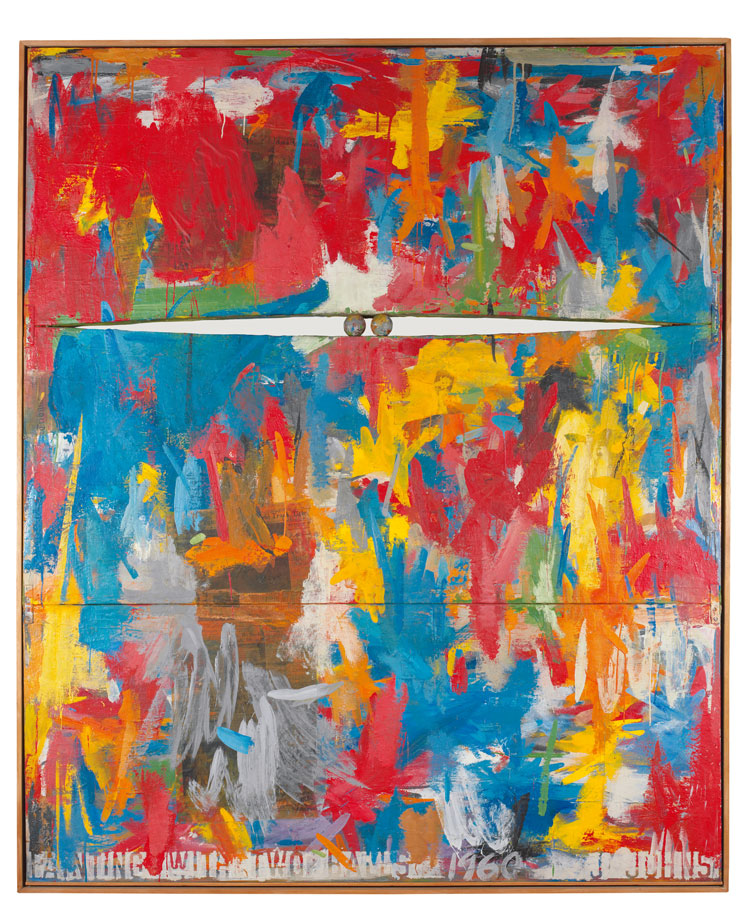
Painting with Two Balls, 1960. Encaustic and collage on canvas with objects (3 panels), 65 x 54 1/8 in (165.1 x 137.5 cm). Collection of the artist. © 2021 Jasper Johns/VAGA at Artists Rights Society (ARS), New York.
Find here, too, Souvenir (1964), whose two light sources, trapped in encaustic, train on each other to leave the Johns portrait ringed by red, blue and yellow drained of colour, and the luminous, obsessively crosshatched Usuyuki (1982), on brief loan from Japan. Rightfully, the focus of an entire gallery, Untitled (1972), not seen outside Cologne in 25 years, transitions from explored to exploratory across crosshatching, flying flagstones and transfixed body parts.
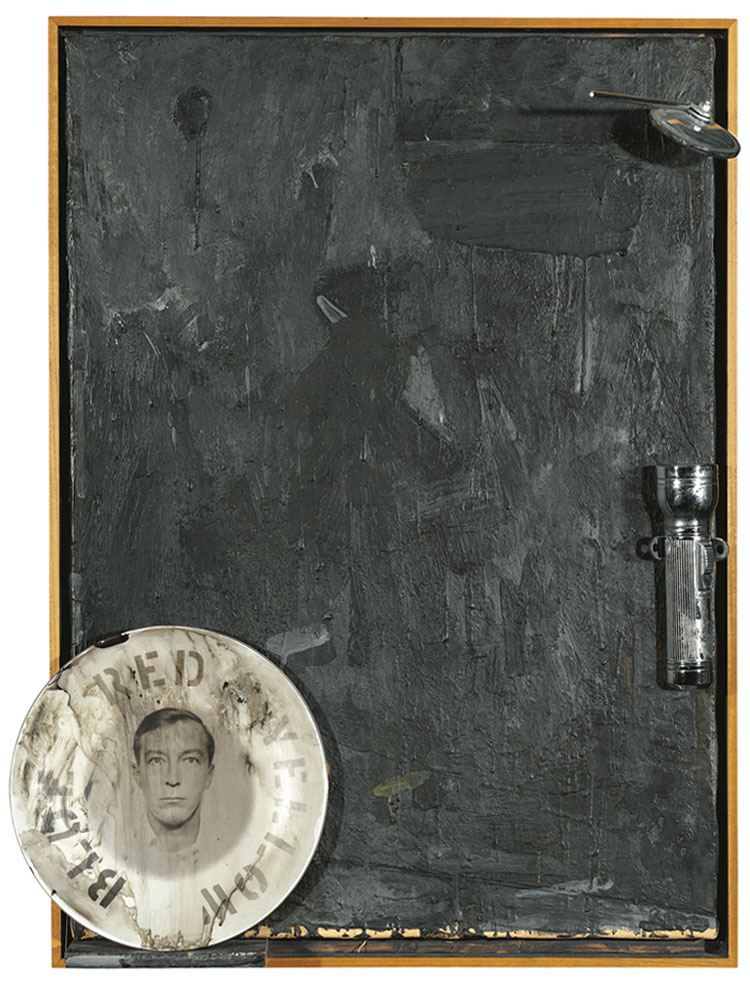
Jasper Johns, Souvenir, 1964. Installation view. Photo: Jill Spalding.
A curatorial plus is the looser chronological order, making it easier to chronicle the crossover relationships between working proofs, paintings, drawings, prints and monotypes. Easily tracked, too, is which artists left their mark. Declaredly, Marcel Duchamp (that twice-appropriated Mona Lisa reduced here to a postage stamp); Edvard Munch (provoking three disembodied renderings of Between the Clock and the Bed); and Paul Cézanne (for his legacy of “the circle, square and triangle that make up the whole world”.)
Less obvious, whom did Johns influence? Easy calls are Robert Gober and Kiki Smith, but the oft-cited Brice Marden, Robert Morris and Richard Serra are such a stretch as to suggest that few younger artists anywhere near his orbit were untouched by him.
I think that the picture isn’t pre-formed, I think it is formed as it is made; and might be anything.
The temptation of a last hurrah retrospective – which this is likely to be – is to look for ultimate meaning. False trail. Basualdo, for one, believes there is none. I am with him. “Ultimate” suggests writing Finis to an oeuvre, whereas Johns’s investigations remain open-ended. On the other hand, it is not overstating it to call ultimate this accolade fully due to an artist for whom art has always been Art, who poses everyday questions to conjure difficult answers, and whose body of work constitutes an exhaustive autobiography.
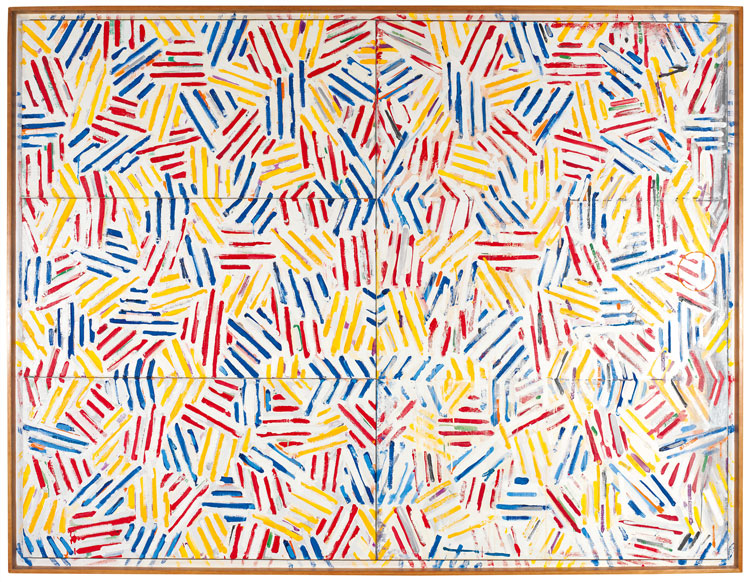
Jasper Johns, Corpse and Mirror II, 1974-75. Oil and sand on canvas (4 panels), 57 5/8 x 75 1/4 in. (146.4 x 191.1 cm). Collection of the Artist. © Jasper Johns / Licensed by VAGA at Artists Rights Society (ARS), New York, NY.
Johns would agree. It speaks to a self-portrait writ in stone – and likely an eponymous foundation down the line – that so many of the great works on show here remain in his personal collection.
Relevant, too, is his age. Compared with the average 40-year lifespan of history’s major artists (with all that time out for travelling when passable roads opened up new commissions), Johns’s arc has spanned the full day’s work of four generations. A retrospective of his life’s work thus takes on cosmic meaning – and that both palette and content remain fertile suggests that his output constitutes an entire ecosystem, one fed by a still-curious mind, agile brush, and memories rich for mining. Even the late works, generally referred to as elegies, call on obsessive innovation.
No greater confirmation than from those attending opening night. Generally more interested in the meet and greet, and skimming the wall labels for who owns what, to a person the VIP attendees stopped in their tracks. Craig Starr of the eponymous gallery summed it up: “This confirms everything I’ve ever thought about Johns, the consistent quality of the work over so many years, the aesthetic, reinvention ….” and when he ran out of superlatives, he threw up his arms and said: “WOW!”